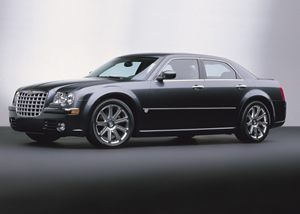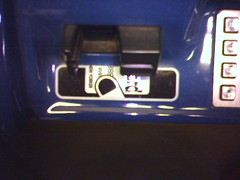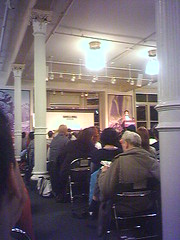Hindus in Europe want to take back the swastika because to them it’s a symbol of luck and peace which the Nazis stole. Meanwhile the European Parliment is considering banning the symbol throughout Europe after Prince Harry of Great Britain wore a mock Nazi uniforn to a costume party.
Month: January 2005
-
IA Leadership Seminar
The early registration deadline for the Information Architecture Institute’s Leadership Seminar is January 28th. If you sign up now you’ll get a significant discount for this star-studded event, 1 ½ days including:
- “Managing Up: The Business Strategy of Information Architecture†– Christina Wodtke and Scott Hirsch
- “The Enterprise IA Roadmap†– Louis Rosenfeld
- â€Homeland Security and IA†– Lee S. Strickland, JD
- “Practical Application of the Semantic Web†– Paul Ford
- “The State of Global IA†– Livia Labate, Peter Van Dijck, Jorge Arango
- “Hands-On Scenario Planning: Looking to the Future to Shape Decisions Today†– Jess McMullin
For more information about the seminar, please check the Institute’s website at http://www.aifia.org/news/ or to register for both the Seminar and the IA Summit, go to http://www.iasummit.org.
-
Disruption in home audio
If you’d like to see the process of a disruptive technology take hold before the disruption, look at the home audio industry.
In the past year or two home audio has taken some interesting turns. Before you basically had two configurations: simpler, inexpensive all-in-one systems or more flexible and expensive separates. Cambridge Soundworks, then Tivoli, erased the difference by bringing us small, high-quality separates mostly by reducing speaker size and increasing speaker efficiency, thereby requiring smaller amplifiers.
Next we saw stereo-computer communication and integration. There’s stereo components with computers inside (e.g. CD+DVD+MP3 for $39) and “sound cards” have turned into receiver replacements. Naturally there’s the next generation of devices that distribute the signal throughout the home. The big question for the consumer amid this mess is: does my computer become the audio hub, do I bridge the computer and stereo together, or do I buy duplicate functionality and keep the systems separate? Expecting the consumer to be home audio network architect isn’t helping anyone, except those who install custom setups for the wealthy.
The phase that’s emerging now is the audiophile killers, true audiophile sound in small packages at previously unthinkable prices. This was started by 47 Labs’s Gaincard amplifier that works not via tubes or traditional solid state circuitry but by using a single chip for amplification. Because it so reduced complexity, the DIY contingent created copies called gainclones that achieve the same sound quality at prices you might pay for an average consumer amp. The next, inevitable, step was to mass produce this approach, which is what Sonic Impact did with the Class T amp ($39, and as low as $19 recently at PC Mall). Audiophiles are going ga ga over it.
The next phase — the distruptive bit — is a when a clueful industrial designer (e.g. Bose, Apple, Griffin, or Taiwan’s BenQ) leverages the chip amp’s low complexity, price and small size to create a $199 stereo system that also solves the audio network architecture problem. The latter, IMHO, means a stereo that is still a stereo (or home theater) that let’s the computer handle the digital audio file part of the equation. This is based on the premise that listening to music/watching television is usually, for most families a different and sometimes simultaneous activity from computing. In this scenario, all the stereo has to do is receive an audio signal over wi-fi and — via a user interface — send some simple signals back to the computer (“Give me the X .mp3 file now”). The computer continues to do everything it does well, with a simple mod to the mp3 player software to broadcast music over wi-fi, as iTunes does today. This results in ease-of-use that crosses the usability chasm, and control over music selections from either the computer or the stereo, something you don’t get with most systems today. All this in a great sounding, small package (chip amp + efficient, small speakers) that will be better than anything home audio can currently offer short of a professionally designed custom system. We could see this by the end of 2005, with competitors playing catch up in 2006.
-
The Paradox of Choice
I meant to make a note of Barry Schwartz’s The Paradox of Choice a while ago, and was reminded of it as it’s now in paperback. The New Yorker review is, as usual, the best introduction to the topic. Excerpts:
As Herbert Simon, the 1978 Nobel laureate in economics, observed, any firm that tried to make decisions that would “maximize†its returns would bankrupt itself in a never-ending search for the best option. What firms do instead is “satisfice,†to use Simon’s term: they content themselves with results that are “good enough.†Schwartz, who is a close reader of Simon, worries that the profusion of choices we face—a hundred varieties of bug spray, breakfast cereal, extra-virgin olive oil—is turning us into maximizers, and maximizers, he thinks, are prone to misery and depression.
Daniel Kahneman and the late Amos Tversky… once asked subjects whether they’d prefer to be making thirty-five thousand dollars a year while those around them were making thirty-eight thousand or thirty-three thousand while those around them were making thirty thousand. They answered, in effect, that it depends on what the meaning of the word “prefer†is. Sixty-two per cent said they’d be happier in the latter case, but eighty-four per cent said they’d choose the former.
In a study conducted several years ago, shoppers who were offered free samples of six different jams were more likely to buy one than shoppers who were offered free samples of twenty-four. …Schwartz suggests that it has to do with the irrational way people measure “opportunity costs.†Instead of calculating opportunity cost as the value of the single most attractive foregone alternative, we seem to assemble an idealistic composite of all the options foregone.
There are even cases, as Schwartz notes, where just one additional choice can produce outright paralysis. Tversky and the young Princeton psychologist Eldar Shafir asked experimental subjects how they would react to a desirable Sony appliance placed in a shopwindow, radically marked down. The offer met with predictable enthusiasm. When a second appliance, similarly marked down, was placed alongside the bargain Sony, enthusiasm—and sales—dropped. Some hypothetical customers were evidently frozen by indecision.
What about the other approach—trying to choose less? In some measure, we all do this, using a strategy that the Columbia social theorist Jon Elster calls “self-binding.†Gilbert and Wilson note that there is one exception to the rule that hungry people overbuy and sated people underbuy at supermarkets: it’s people who bring a grocery list, which the two psychologists call “a copy of A Theory About What I Will Want in the Future.â€
People are consistently puzzled that so many things they had dreaded—from getting fired to being ditched by a spouse—“turned out for the best.†…A tendency to overestimate the joy we’ll get from buying baubles and winning honors is only half of a complex predisposition. The other half is our enormous capacity for happiness, even in the absence of such things. The surprise isn’t how often we make bad choices; the surprise is how seldom they defeat us.
-
Flickr tag: cardreader
Mike Lee sparked my interest in observing how many different ways designers tell us to insert a card into a machine. It’s interesting 1) because there are so many different ways, and 2) because many are confusing in that fascinating why-did-they-do-it-that-way? way.
If you’d like to contribute, just add the tag “cardreader” to your pics.
-
The new global currency?
The Economist says, tongue-in-cheek:
…the dollar has been dethroned even sooner than we expected. It has been superseded not by the euro, nor by the yen or yuan, but by another increasingly popular global currency: frequent-flyer miles.
Turns out there’s about $14 trillion in frequent flier miles in circulation.
-
Malcolm Gladwell blinks
I just saw Malcolm Gladwell do a book tour talk. With “The Tipping Point” and now “Blink” it’s clear he’s a student of change. In his new book he looks at the ability of the adaptive unconscious to make good decisions because it’s been trained through experience. The implications for practice and iteration are directly relevant for designers.
He says, “Decisions made very quickly can be every bit as good as decisions made cautiously and deliberately” — especially by those with expertise — but this requires “changing the environment in which the snap judgment is made.” Often this means less information is better. A mass of information is alright when planning, but when action is needed too much information brings with it dangers of bias and drowning in data.
Later… I suddenly realize Gladwell is applying neural network theory in reverse. We’ve built articificial networks modeled on the brain and train them, fine tuning the weight of each node. Then we expect the computerized versions to make decisions instantaneously, not mull it over. Gladwell seems to be saying once we’ve trained our neural networks similarly, we too can make effective instantaneous decisions.
-
We are all in this together
Just returned from San Francisco where one of the best things I saw was a billboard of Mark Mumford’s WE ARE ALL IN THIS TOGETHER.
-
NYC Lectures, Jan 2005
Malcolm Gladwell talks about his new book, Blink, at Barnes and Noble Union Square at 7pm on January 13th. Free.
Jared Diamond lectures on his new book at the 92nd St Y, 7:30pm on Jan 16. $25.
The editors and writers of a new magazine called Plenty discuss the mag’s view on the intersection of business, products and environmentalism, at my local The Half King, 23rd St west of 10th Ave, at 7pm on January 17th. Free.
-
The Daimler-Chrysler merger at work
James Cobb of the New York Times generates the latest praise for the Chrysler 300 and adds,
It also melds Stuttgart engineering with Detroit style, providing a rebuttal to those who were skeptical – we know who we are – of Daimler’s takeover of Chrysler. Beneath its audacious design, the 300 is packed with well-engineered parts shared with the pricier Mercedes E-Class. The old Chrysler Corporation could not have produced such a well-rounded, well-engineered, well-made car on its own. Nor could Mercedes have designed such an audaciously American car or sold it such an accessible price.

That’s good news for them when you see how competitors like Renault and Scion aren’t afraid to take chances.


